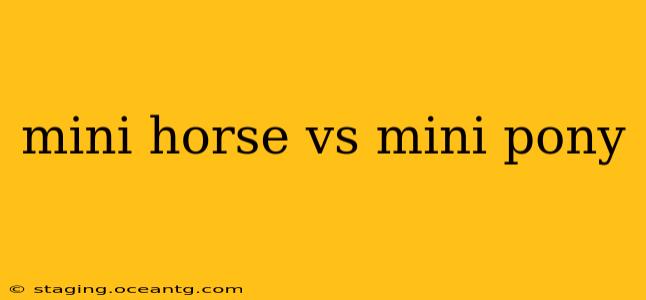The terms "mini horse" and "mini pony" are often used interchangeably, leading to confusion. While both are small equines, there are key distinctions based on genetics, conformation, and even temperament. Understanding these differences is crucial for anyone considering owning one of these charming creatures.
What is a Miniature Horse?
Miniature horses are essentially smaller versions of full-sized horses. They share the same genetic lineage and possess the characteristic horse-like features, albeit on a smaller scale. This means their bone structure, build, and overall conformation are more refined and leaner than ponies. They are bred for their refined appearance and often exhibit a more elegant carriage.
Key Features of Miniature Horses:
- Refined bone structure: Generally, miniature horses have a finer bone structure compared to ponies.
- Longer legs: Relative to their body size, they tend to have longer legs.
- Leaner build: They often have a more athletic and lean build.
- Elegant carriage: Their posture and movement often possess a graceful quality.
- Height restriction: Breed registries typically define miniature horses based on height at the withers (the highest point of the shoulders), usually under 34 inches.
What is a Miniature Pony?
Miniature ponies, on the other hand, are smaller versions of various pony breeds. They retain the stockier build and more robust bone structure characteristic of their larger pony counterparts. Their overall appearance is often more compact and less refined than miniature horses.
Key Features of Miniature Ponies:
- Stockier build: Compared to miniature horses, they have a more compact and sturdy build.
- Thicker bone structure: Miniature ponies generally have thicker bones.
- Shorter legs: Their legs are proportionally shorter compared to their body size.
- More robust body type: They tend to be more muscular and less refined in appearance.
- Height restriction: Height limitations vary depending on the specific pony breed they are registered with, usually falling under 34 inches as well, but conformation is the key differentiator.
What's the Difference in Temperament?
While generalizations about temperament are risky, some breeders and owners note subtle differences. Miniature horses, due to their breeding towards a more refined appearance, might be perceived as slightly more sensitive or high-strung by some, while miniature ponies, with their stockier build and potentially more robust heritage, might exhibit a more sturdy and even-tempered nature. However, individual personalities will vary greatly, regardless of whether the animal is a miniature horse or pony.
How are they used differently?
Both miniature horses and ponies are often cherished as companions. Their smaller size makes them ideal for smaller living spaces, though adequate pasture and exercise are crucial for their health. However, some breeds of miniature horses are also used in driving competitions, showing their refined athleticism. Many miniature ponies also excel in driving.
How can you tell them apart?
Distinguishing between a mini horse and a mini pony often requires a trained eye. The subtle differences in conformation, bone structure, and overall build are the most reliable indicators. Looking at the animal's lineage and registration papers can provide definitive confirmation of its classification. If you are unsure, consulting with an experienced equine veterinarian or breed expert is highly recommended.
What are the common miniature horse and pony breeds?
Many breeds fall under both categories, often sharing overlapping characteristics. Looking up specific breed registries is helpful in understanding these nuances. Some well known breeds include Falabella (often classified as a horse), Shetland pony (miniatures are common), and American Miniature Horse.
Are there health differences between mini horses and ponies?
Generally, miniature horses and ponies face similar health challenges associated with their small size. These can include dental issues, metabolic disorders, and certain musculoskeletal problems. Regular veterinary care is crucial for both types of miniature equines.
This comprehensive guide clarifies the often-blurred lines between miniature horses and ponies, highlighting their unique characteristics and offering valuable insights for potential owners and enthusiasts. Remember, individual variations exist, and the best way to determine the specific type of equine is through professional assessment and registration documentation.
